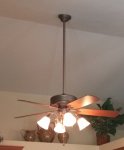flywright52
Member
- Location
- Missouri
I have a customer who would like to modify a ceiling fan light fixture in the kitchen to give more output - even if the fan is no longer operational. I have 4-12 watt LED candelabra bulbs (85-100W equivalent) that give all the light she would like, but of course, they do not play well with the watt limiter in the fan light (unless you like disco lighting). Also, this exceeds the limit of 190W regulation for a ceiling fan light kit.
I am considering converting the fixture to a light-only fixture and removing the fan motor, capacitor and blades. I would also remove the watt limiter for the lights. In my opinion, the fixture becomes a light only fixture at that point. I would be wiring directly from the junction box to the 4 light sockets at that point.
Is this legal?

I am considering converting the fixture to a light-only fixture and removing the fan motor, capacitor and blades. I would also remove the watt limiter for the lights. In my opinion, the fixture becomes a light only fixture at that point. I would be wiring directly from the junction box to the 4 light sockets at that point.
Is this legal?

